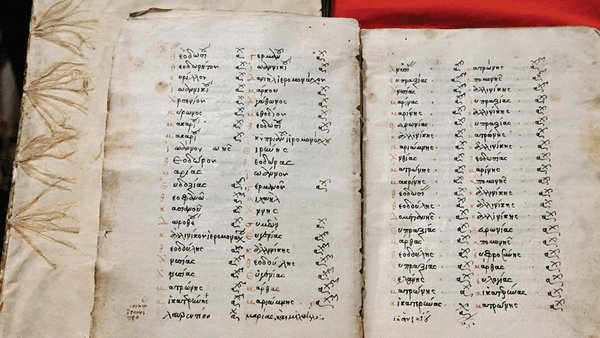

In 2008, Swann Auction Galleries in Manhattan sold three Greek-language manuscripts from the 16th and 17th centuries to an antiquities dealer who returned them two years later after concluding they might have been looted.
The dealer was reimbursed, but the auction house, its officials said, was unable to reach the person who had consigned the items. So, they sat on a shelf for more than a decade, all but lost in the shuffle of daily operations.
Three months ago, though, the manuscripts resurfaced when Swann’s chief financial officer went through his office before a renovation. There on a shelf in a long-forgotten plastic bag were the manuscripts, which are believed to have been stolen from a Greek monastery in the midst of World War I.
They are thought to have been lost in 1917 when Bulgarian combatants are said to have plundered nearly 900 items from the Theotokos Eikosiphoinissa Patriarchal and Stavropegial Monastery, often called Kosinitza, in northern Greece.
The manuscripts will be sent back to the monastery, and their return was commemorated on Friday in a repatriation ceremony in lower Manhattan. After the ceremony, arranged by the Greek Orthodox Archdiocese of America, Archbishop Elpidophoros of America was planning to travel to Constantinople to deliver the manuscripts to Ecumenical Patriarch Bartholomew, leader of the Eastern Orthodox Church. From there, the items will go back to Kosinitza.
“It is a blessing for the monastic sisterhood at the monastery of Theotokos Eikosiphoinissa to see the contents of their former library slowly being returned to them,” Elpidophoros said in a statement. He said the church hopes that other organisations with manuscripts stolen from the monastery would also return them.
The sweeping scale of systematic looting during World War II by Nazi forces tends to overshadow the fact that artworks were routinely plundered during other conflicts. Roman generals, Alexander the Great and Napoleon Bonaparte were known to have looted artworks during military campaigns, said Leila Amineddoleh, a lawyer who specialises in art and cultural heritage law and who has been serving as a consultant for lawyers seeking the return of documents they say were taken from the monastery.
But although some looting efforts are carried out in an organised fashion on behalf of an empire and its aspirations, Amineddoleh said the turmoil of war also provides cover for thefts by fighters who act on their own, not on orders.
“Sometimes, looting is done nation to nation,” she said. “Sometimes, it’s done by individuals as a crime of opportunity.”
The plundering of Kosinitza would appear to fall into the second category. The monastery was founded in about the fifth century and, by the 18th century, was said to have a collection of about 1,300 volumes, an Eastern Orthodox Church official wrote in a letter in 2015. The official added that the monastery was attacked in 1917 by “marauding Bulgarian guerilla forces” who sacked its library. — NYT
Oman Observer is now on the WhatsApp channel. Click here


